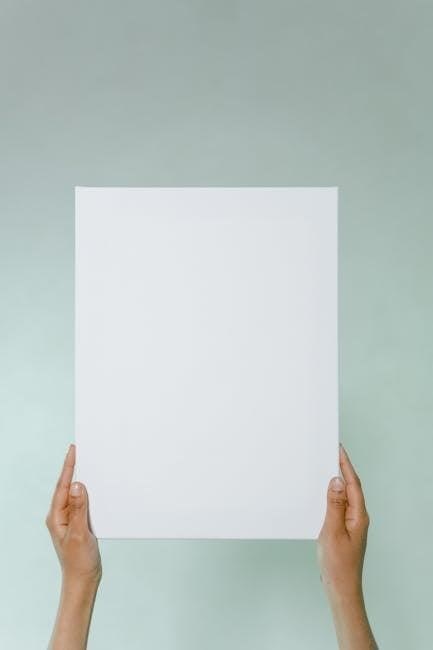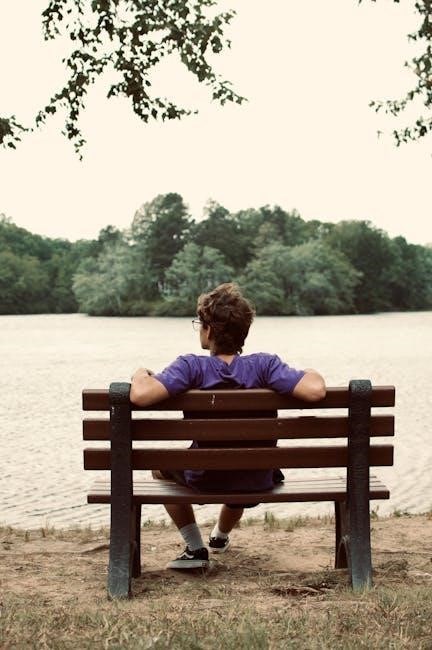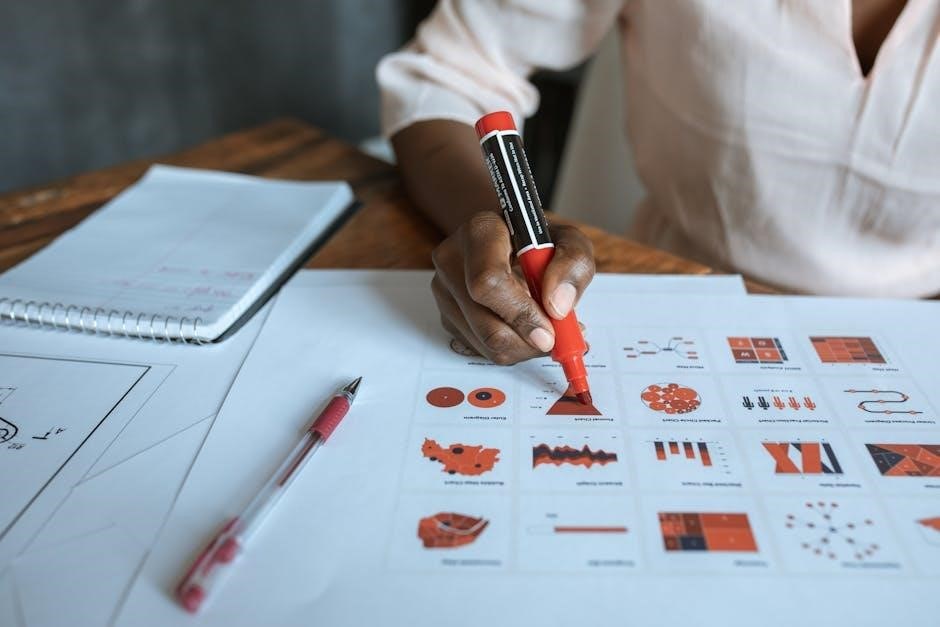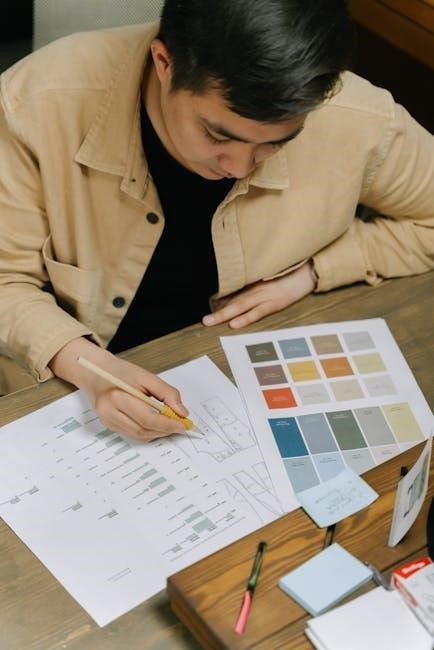Welcome to the Hoover FH50700 manual‚ your comprehensive guide to understanding and maintaining your PowerDash carpet cleaner. This manual provides essential information on key features‚ safety precautions‚ and maintenance tips to ensure optimal performance and longevity of your device.
1.1 Overview of the Hoover FH50700
The Hoover FH50700 PowerDash is a compact and lightweight carpet cleaner designed for efficient cleaning of carpets‚ upholstery‚ and pet stains. Part of Hoover’s PowerDash series‚ it offers powerful suction and steam cleaning capabilities‚ making it ideal for deep cleaning and maintaining various surfaces. With its portable design‚ it simplifies cleaning tasks while ensuring effective results. This model is particularly praised for its ease of use and versatility in handling different cleaning needs‚ making it a practical choice for both small and large cleaning projects.
1.2 Importance of Reading the Manual
Reading the Hoover FH50700 manual is crucial for understanding its features‚ operation‚ and maintenance. It provides essential safety guidelines‚ warranty details‚ and troubleshooting tips to ensure proper usage. By following the manual‚ users can optimize performance‚ avoid potential damage‚ and extend the product’s lifespan. It also helps in identifying compatible accessories and understanding electrical requirements. Familiarizing yourself with the manual ensures safe and efficient operation‚ maximizing your cleaning experience and investment in the Hoover PowerDash FH50700.

Key Features of the Hoover FH50700
The Hoover FH50700 features a compact‚ portable design with powerful cleaning capabilities‚ ensuring efficient and effective cleaning for various surfaces.
2.1 Cleaning Capabilities
The Hoover FH50700 excels in deep cleaning carpets and upholstery with its powerful suction and advanced cleaning solution distribution system. It effectively removes dirt‚ stains‚ and pet dander‚ ensuring a thorough cleaning experience. The device is designed to handle various surfaces‚ including stairs and hard-to-reach areas‚ making it versatile for different cleaning tasks. Its efficient performance makes it ideal for maintaining clean and hygienic environments in homes and offices. Regular use ensures long-lasting freshness and extends the life of your carpets and upholstery.
2.2 Design and Portability
The Hoover FH50700 features a lightweight and compact design‚ making it highly portable for easy maneuverability around the home. Its ergonomic construction ensures comfortable handling‚ while the sleek layout allows for seamless navigation across various surfaces. The device is built with durability in mind‚ combining robust materials with a user-friendly interface. Its compact size also makes it easy to store‚ saving space while maintaining accessibility. This design ensures that users can efficiently clean without strain‚ making it perfect for both quick touch-ups and deep cleaning sessions.
2.3 Accessories Included
The Hoover FH50700 comes with a range of convenient accessories to enhance your cleaning experience. These include a solution tank cap‚ a crevice tool for tight spaces‚ and an upholstery brush for delicate surfaces. Additional components like replacement brushes and cleaning pads may also be provided‚ depending on the package. These accessories ensure versatility‚ allowing you to tackle various cleaning tasks efficiently. The inclusion of these tools underscores Hoover’s commitment to providing a comprehensive cleaning solution tailored to different user needs and preferences.

Technical Specifications
The Hoover FH50700 is a compact steam cleaner designed for efficient performance. It features a lightweight‚ portable design‚ making it ideal for cleaning carpets‚ rugs‚ and similar surfaces effectively.
3.1 Power Requirements
The Hoover FH50700 operates on a nominal 120-volt circuit‚ ensuring efficient performance for cleaning tasks. It features a grounding plug for enhanced safety‚ adhering to electrical safety standards. The device is designed to be energy-efficient‚ providing consistent power for optimal cleaning results. Always ensure the unit is plugged into a properly grounded outlet to avoid potential hazards. Refer to the data plate on the device for exact voltage requirements and guidelines for safe operation.
3.2 Tank Capacity
The Hoover FH50700 features a solution tank with a capacity designed to handle extended cleaning sessions without frequent refills. The dirt tank is also sufficiently sized to collect debris effectively; Regularly monitoring the tank levels ensures optimal performance and prevents overflow or suction issues. Proper maintenance‚ including cleaning the tanks after use‚ is crucial for maintaining hygiene and the longevity of the device. Always follow the manufacturer’s guidelines for filling and emptying the tanks to ensure safe and efficient operation.
3.4 Weight and Dimensions
The Hoover FH50700 is designed with portability in mind‚ featuring a lightweight and compact frame. Its dimensions ensure easy maneuverability‚ allowing users to clean various spaces efficiently. The weight is balanced to provide stability while maintaining ease of transport. These specifications make the device ideal for both small and large cleaning tasks‚ ensuring convenience without compromising performance. The compact design also enables effortless storage‚ making it a practical addition to any cleaning routine.

Safety Precautions
Always follow electrical safety guidelines and ensure proper assembly before use. Avoid using the cleaner as a vacuum and keep it out of reach of children.
4.1 General Safety Guidelines
To ensure safe operation‚ always follow these guidelines: unplug the device before maintenance‚ avoid exposure to hot surfaces‚ and keep the area clear of obstacles. Use only genuine Hoover parts and adhere to the manufacturer’s instructions. Regularly inspect the power cord and avoid overloading electrical circuits. Maintain a stable work surface and prevent children from accessing the cleaner. Follow all safety precautions outlined in the manual to minimize risks and ensure effective cleaning performance.
4.2 Electrical Safety
Always use the Hoover FH50700 on a nominal 120-volt circuit with a grounding plug. Avoid exposing the device to water or operating it in damp environments. Never submerge electrical components in water or use damaged cords. Ensure the power cord is stored properly to prevent tangling or damage. If unsure about electrical connections‚ consult a licensed electrician. Follow all electrical safety guidelines in the manual to prevent hazards and ensure safe operation.
4.3 Usage Restrictions
The Hoover FH50700 is designed for cleaning carpets‚ rugs‚ and similar surfaces. Avoid using it on hardwood‚ tile‚ or surfaces not specified in the manual. Do not use the device as a traditional vacuum cleaner. Always vacuum thoroughly before using the cleaner. Ensure the device is used only for its intended purpose to avoid damage. Keep it out of reach of children and avoid operating it in wet conditions. Follow all usage guidelines to maintain performance and safety.

Assembly and Setup
The Hoover FH50700 is designed for carpets and rugs. Avoid using it on hardwood‚ tile‚ or surfaces not specified in the manual. Do not use it as a traditional vacuum. Always vacuum thoroughly before using the cleaner. Keep the device away from children and avoid operating it in wet conditions. Use only for its intended purpose to ensure optimal performance and safety. Follow all guidelines to maintain effectiveness and prevent damage.
5.1 Unpacking the Device
Begin by carefully unpacking the Hoover FH50700 from its box. Inside‚ you will find the main unit‚ clean water tank‚ dirty water tank‚ cleaning brush‚ and other accessories. Check for any visible damage or missing parts. Ensure all components are included‚ such as the power cord‚ user manual‚ and additional cleaning tools. Before assembly‚ inspect each part for proper condition. This step ensures a smooth setup process and prevents potential issues during use. Refer to the manual for a detailed list of included items and initial checks. Proper unpacking is essential for safe and efficient operation.
5.2 Attaching Accessories
Attach the cleaning brush and other accessories to the Hoover FH50700 by aligning the connectors properly. Gently snap the brush into place until it clicks securely. Ensure all parts are fitted correctly to avoid loose connections during use. For additional tools like the upholstery brush‚ follow the same alignment process. Refer to the user guide for specific diagrams or instructions. Properly attaching accessories ensures optimal cleaning performance and prevents damage to the device or surfaces being cleaned. Always check the connections before starting your cleaning task.
5;3 Initial Maintenance Checks
Before first use‚ inspect the Hoover FH50700 for any damage or blockages. Ensure the brush roll is clean and free of debris. Check the solution tank for leaks and verify all connections are secure. Test the power cord and ensure it is undamaged. Familiarize yourself with the controls and settings. Regularly clean the filter and empty the dirty water tank to prevent buildup. Always refer to the manual for specific maintenance recommendations to keep your cleaner functioning at its best and extend its lifespan.
Operating Instructions
Follow these operating instructions for the Hoover FH50700 to ensure safe and effective cleaning. Plug in the device‚ fill the solution tank‚ and adjust settings as needed. Always refer to the manual for specific guidelines.
6.1 Pre-Cleaning Steps
Before using the Hoover FH50700‚ ensure the area is clear of loose debris by vacuuming thoroughly. Remove any large objects or furniture to allow unrestricted cleaning. Check for stains or high-traffic areas and pre-treat them if necessary. Always test a small‚ inconspicuous section of the carpet to ensure colorfastness. Fill the solution tank with the recommended cleaner and water mixture‚ avoiding overfilling. Finally‚ ensure the device is turned off and unplugged before adding cleaning solutions or making adjustments.
6.2 Using the Cleaner
To use the Hoover FH50700‚ turn the unit on and select the appropriate cleaning mode. Slowly move the cleaner forward‚ overlapping strokes to ensure thorough coverage. Apply gentle to moderate pressure‚ depending on the surface. For stains‚ pause briefly while the brush roll agitates the area. Avoid over-saturating the carpet by releasing the trigger when changing direction. Regularly empty and rinse the recovery tank to maintain cleaning efficiency. Always refer to the manual for specific guidance on different surfaces and stain removal.
6.3 Cleaning Different Surfaces
The Hoover FH50700 is designed to clean various surfaces effectively. For carpets‚ use the standard cleaning mode with the brush roll engaged. Upholstery can be cleaned using the handheld attachment‚ while hard floors require the hard floor cleaning mode with the brush roll disengaged. Always test a small area first to ensure compatibility. For pet stains or high-traffic areas‚ apply the cleaning solution directly and let it sit before scrubbing. Avoid using the cleaner on sensitive or delicate surfaces without proper settings to prevent damage.

Maintenance and Troubleshooting
Regular maintenance ensures optimal performance. Clean the brush roll after each use and check for blockages. Empty the tank after cleaning to prevent mold growth.
7.1 Regular Cleaning Tips
Regular maintenance is essential for optimal performance. After each use‚ empty and rinse the solution tank thoroughly to prevent mold growth. Clean the brush roll by removing any tangled hair or debris. Check for blockages in the hose or nozzle and clear them promptly. Rinse filters with warm water and allow them to dry completely before reinstalling; For tough stains‚ soak the brush roll in warm soapy water. Regularly inspect and replace worn-out parts to ensure efficient cleaning. Proper care extends the lifespan of your Hoover FH50700.
7.2 Common Issues and Solutions
Address common issues to ensure your Hoover FH50700 functions optimally. If the brush roll stops spinning‚ check for blockages or tangled hair. For low suction power‚ ensure the filters are clean and free of debris. If the machine leaks‚ inspect the solution tank for cracks or loose connections. To eliminate odors‚ rinse and dry the tank thoroughly after use. Regularly cleaning the hose and nozzle can prevent clogs. Refer to the manual for detailed troubleshooting steps to resolve issues quickly and effectively.
7.3 Storing the Device
Proper storage ensures your Hoover FH50700 remains in excellent condition. After use‚ clean and dry the device thoroughly to prevent mold or odors. Drain the solution and water tanks completely to avoid mineral buildup. Store the cleaner in a cool‚ dry place‚ away from direct sunlight. Ensure all accessories are securely stored to prevent loss or damage. Keep the device out of reach of children and pets for safety. Regular storage maintenance helps maintain performance and longevity.

User Manual Details
The Hoover FH50700 manual is available in PDF format‚ offering detailed instructions in multiple languages. It includes guides for operation‚ maintenance‚ and troubleshooting‚ ensuring comprehensive user support.
8.1 Downloading the Manual
To access the Hoover FH50700 manual‚ visit the official Hoover website or trusted manual databases like ManualsLib or Manua.ls. The manual is available in PDF format‚ free for download. It covers essential topics such as safety guidelines‚ operating instructions‚ and troubleshooting. Ensure to download the correct version for your model to get accurate information. The PDF includes detailed diagrams and step-by-step instructions to help you make the most of your PowerDash cleaner. Downloading the manual is a straightforward process that requires no registration or payment.
8.2 Navigating the Manual
The Hoover FH50700 manual is designed to be user-friendly‚ with a clear table of contents and organized sections. Start with the index to quickly locate specific topics. Each chapter is labeled with bold headings‚ making it easy to find information on operation‚ maintenance‚ and troubleshooting. Detailed diagrams and bullet points enhance readability‚ while page references guide you to related sections. Familiarize yourself with the manual’s structure to efficiently access the information you need‚ ensuring you get the most out of your PowerDash cleaner.
8.3 Additional Resources
For further assistance‚ visit the official Hoover website or access the customer support page for detailed guides‚ FAQs‚ and troubleshooting tips. Additionally‚ downloadable resources like the full PDF manual and maintenance guides are available online. Explore Hoover’s official YouTube channel for tutorial videos and product demonstrations. These resources provide comprehensive support to help you maximize the performance and longevity of your Hoover FH50700 PowerDash cleaner‚ ensuring you have all the tools needed for optimal use and care.
Accessories and Parts Compatibility
The Hoover FH50700 is compatible with official accessories like solution tank caps and brush rolls. Ensure all parts are genuine Hoover products for optimal performance and compatibility.
9.1 Official Accessories
The Hoover FH50700 is designed to work seamlessly with official accessories‚ including the solution tank cap and brush roll. These genuine parts ensure optimal performance and longevity. For detailed compatibility‚ refer to the official manual or visit the Hoover website. Using authentic accessories guarantees safety and maintains warranty validity. Always check for Hoover-verified products to avoid compatibility issues and ensure your device operates efficiently. The manual provides a comprehensive list of recommended accessories and maintenance schedules for your PowerDash cleaner.
9.2 Replacement Parts
Replacement parts for the Hoover FH50700 are available through the official Hoover website and authorized retailers. These include components like brush rolls‚ solution tank caps‚ and belts. Using genuine Hoover parts ensures compatibility and maintains the device’s performance. For maintenance‚ refer to the manual’s guidelines on replacing worn or damaged parts. Always check the compatibility of replacement parts with your specific model to avoid malfunctions. Genuine parts are designed to meet safety standards and maintain warranty coverage‚ ensuring your cleaner operates efficiently and effectively over time.

Warranty and Support
Your Hoover FH50700 comes with a comprehensive warranty covering parts and labor for a specified period. For support‚ visit the official Hoover website or contact customer service for assistance with repairs‚ troubleshooting‚ or general inquiries. Refer to the manual for detailed warranty terms and conditions.
10.1 Warranty Information
The Hoover FH50700 is backed by a comprehensive warranty that covers parts and labor for a specified period. The warranty ensures protection against manufacturing defects‚ providing peace of mind for users. For detailed warranty terms‚ including duration and coverage‚ refer to the official manual or contact Hoover’s customer support. Proper registration and maintenance of the device are essential to uphold warranty benefits. In case of issues‚ reach out to Hoover’s support team for assistance with claims or repairs.
10.2 Customer Support Contact
For assistance with your Hoover FH50700‚ visit the official Hoover customer support page. You can access live chat‚ phone‚ or email support 24/7. The website also offers a chatbot to help with common inquiries. Additionally‚ product manuals‚ troubleshooting guides‚ and warranty information are available online. For parts or repairs‚ contact Hoover directly or visit authorized service centers. Ensure to have your device’s serial number ready for faster assistance. Hoover’s support team is dedicated to resolving issues and providing solutions to enhance your cleaning experience with the PowerDash FH50700.

Environmental Considerations
The Hoover FH50700 is designed with eco-friendly features‚ including energy efficiency and reduced water consumption. Proper disposal of the device and its parts is crucial to minimize environmental impact. Users are encouraged to recycle components and follow local regulations for electronic waste. Additionally‚ using biodegradable cleaning solutions aligns with environmental care. Hoover promotes sustainable practices‚ ensuring the PowerDash FH50700 contributes to a greener future while maintaining cleaning performance. Always consider eco-conscious methods when using and maintaining your cleaner.
11.1 Eco-Friendly Features
The Hoover FH50700 incorporates eco-friendly features to minimize its environmental footprint. Its compact design reduces material usage‚ while energy-efficient technology lowers power consumption. The cleaner uses less water compared to traditional models‚ promoting water conservation. Additionally‚ the device relies on steam cleaning‚ which reduces the need for harsh chemicals. By utilizing biodegradable cleaning solutions‚ users can further align with eco-conscious practices. These features make the Hoover FH50700 a sustainable choice for maintaining a cleaner home while caring for the planet.
11.2 Proper Disposal
Proper disposal of the Hoover FH50700 is crucial for environmental protection. Users should recycle the device through authorized e-waste centers to ensure safe handling of electronic components. Check local regulations for guidelines on disposing of batteries and electrical parts. Additionally‚ any cleaning solutions or chemicals should be disposed of responsibly‚ following community hazardous waste protocols. Ensuring eco-friendly disposal helps reduce environmental impact and promotes sustainability.

Frequently Asked Questions (FAQs)
- Where can I download the Hoover FH50700 manual?
The manual is available for free download on official Hoover websites or platforms like manua.ls.
- How do I maintain the cleaner for optimal performance?
Regularly clean the brush roll and check for blockages in the solution tank and hoses.
- Can I use the cleaner on hard floors?
No‚ the Hoover FH50700 is designed specifically for carpets and upholstery.
12.1 Common User Queries
Users frequently ask about downloading the manual‚ maintenance tips‚ and troubleshooting common issues like clogged hoses or brush roll malfunction. Others inquire about compatibility with hard floors and pet hair removal efficiency. Some seek guidance on emptying the solution tank or resetting the machine after an error. Additionally‚ queries about warranty details and where to find replacement parts are common. These questions highlight the most pressing concerns users have when operating the Hoover FH50700.
12.2 Solutions to FAQs
For downloading the manual‚ visit Hoover’s official website or trusted manual repositories. Regular maintenance involves cleaning brushes and checking for blockages. To resolve clogged hoses‚ disconnect and rinse thoroughly. For hard floor compatibility‚ ensure the correct setting is selected. Enhance pet hair removal by using the provided pet tool. Empty the solution tank after each use to prevent mold. Warranty details are outlined in the manual or on Hoover’s support page. Contact customer support for replacement parts or troubleshooting assistance.
The Hoover FH50700 manual serves as your complete guide to maximizing the potential of your PowerDash carpet cleaner. With its eco-friendly design‚ efficient cleaning capabilities‚ and easy maintenance‚ this device is perfect for keeping your home spotless. By following the manual’s instructions‚ you can ensure optimal performance and extend the lifespan of your cleaner. Refer to the troubleshooting section for quick solutions to common issues. Enjoy a cleaner‚ healthier home with your Hoover FH50700‚ backed by reliable customer support and a comprehensive warranty.



















































